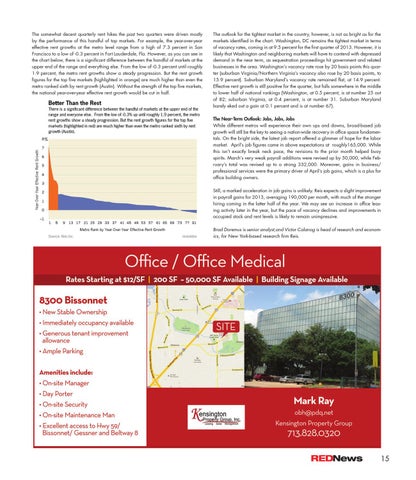The somewhat decent quarterly rent hikes the past two quarters were driven mostly by the performance of this handful of top markets. For example, the year-over-year effective rent growths at the metro level range from a high of 7.3 percent in San Francisco to a low of -0.3 percent in Fort Lauderdale, Fla. However, as you can see in the chart below, there is a significant difference between the handful of markets at the upper end of the range and everything else. From the low of -0.3 percent until roughly 1.9 percent, the metro rent growths show a steady progression. But the rent growth figures for the top five markets (highlighted in orange) are much higher than even the metro ranked sixth by rent growth (Austin). Without the strength of the top five markets, the national year-over-year effective rent growth would be cut in half.
The outlook for the tightest market in the country, however, is not as bright as for the markets identified in the chart. Washington, DC remains the tightest market in terms of vacancy rates, coming in at 9.5 percent for the first quarter of 2013. However, it is likely that Washington and neighboring markets will have to contend with depressed demand in the near term, as sequestration proceedings hit government and related businesses in the area. Washington’s vacancy rate rose by 20 basis points this quarter (suburban Virginia/Northern Virginia’s vacancy also rose by 20 basis points, to 15.9 percent). Suburban Maryland’s vacancy rate remained flat, at 14.9 percent. Effective rent growth is still positive for the quarter, but falls somewhere in the middle to lower half of national rankings (Washington, at 0.5 percent, is at number 25 out of 82; suburban Virginia, at 0.4 percent, is at number 31. Suburban Maryland barely eked out a gain at 0.1 percent and is at number 67). The Near-Term Outlook: Jobs, Jobs, Jobs While different metros will experience their own ups and downs, broad-based job growth will still be the key to seeing a nation-wide recovery in office space fundamentals. On the bright side, the latest job report offered a glimmer of hope for the labor market. April’s job figures came in above expectations at roughly165,000. While this isn’t exactly break neck pace, the revisions to the prior month helped buoy spirits. March’s very weak payroll additions were revised up by 50,000, while February’s total was revised up to a strong 332,000. Moreover, gains in business/ professional services were the primary driver of April’s job gains, which is a plus for office building owners. Still, a marked acceleration in job gains is unlikely. Reis expects a slight improvement in payroll gains for 2013, averaging 190,000 per month, with much of the stronger hiring coming in the latter half of the year. We may see an increase in office leasing activity later in the year, but the pace of vacancy declines and improvements in occupied stock and rent levels is likely to remain unimpressive.
Brad Doremus is senior analyst,and Victor Calanog is head of research and economics, for New York-based research firm Reis.
15
